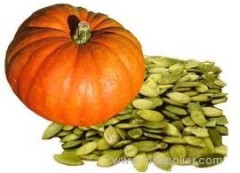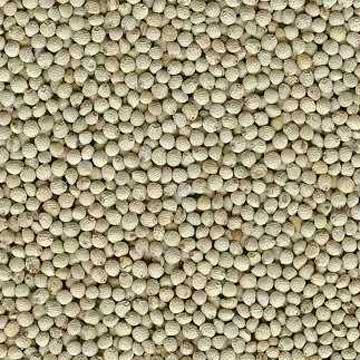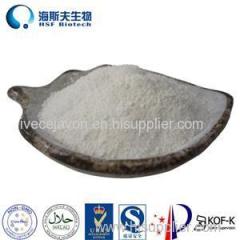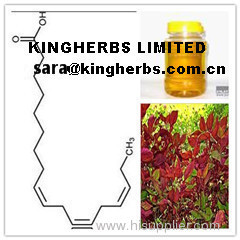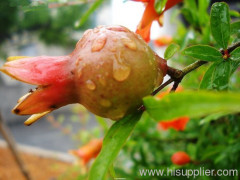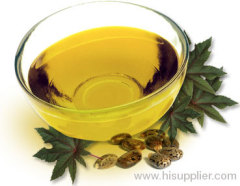
China perilla seed oil
| Payment Terms: | L/C, T/T |
|---|---|
| Supply Ability: | 500kgs |
| Place of Origin: | Hunan |
Company Profile
| Location: | Changsha, Hunan, China (Mainland) |
|---|---|
| Business Type: | Trading Company |
Product Detail
| Production Capacity: | 500kgs |
|---|
Product Description
latin name:perilla frutescens (l. ) brltt.
plant part used:seeds
processing type: cold pressed
appearance:light clear bright yellow oily liquid
active substances: alpha linolenic acid
common specification:hplc
specifications:alpha linolenic acid? ? ? 60
molecular formula:c18h30o2
molecular weight:278. 43
cas no. : 68132-21-8
introduction:perilla oil is obtained from the seeds of annual herbs of the genus perilla, usually perilla frutescens. The seeds contain 35 to 45 percent oil which is obtained by pressing. Perilla oil is used along with synthetic resins in the production of varnishes. Perilla oil dries faster than linseed oil and on drying forms a film that is harder and yellows more than that formed by linseed oil. The paint and varnish industry accounts for the largest usage. Perilla oil also is important in the manufacture of printing inks and linoleum, and in more ancient times was a critical component in creating durable earthen floors. Perilla oil is a very rich source of alpha-linolenic acid. About 50 to 60% of perilla oil is alpha-linolenic acid. Alpha-linolenic acid is an n-3 (omega-3) all-cis polyunsaturated fatty acid containing 18 carbon atoms and three double bonds. It is also known as ala; ala, 18:3n-3; 9,12, 15-octadecatrienoic acid and (z,z, z)-9,12,15-octadecatrienoic acid.
function:1. To lower blood fat. According to the study by zhara, perilla oil can prevent the platelet from aggregating, lower the neutral lipids in blood, remove cholesterol and prevent thrombosis.
2. To nourish the brain and enhance memory dha synthesized by ? ? - linolenic acid can be found in the cerebral cortex, retina, and germ cell with great quantity. It can also cause the growth of the synapse of cranial nerves cell so as to improve memory.
3. To resist senility.
4. To prevent cancer.
5. To prevent allergy.
plant part used:seeds
processing type: cold pressed
appearance:light clear bright yellow oily liquid
active substances: alpha linolenic acid
common specification:hplc
specifications:alpha linolenic acid? ? ? 60
molecular formula:c18h30o2
molecular weight:278. 43
cas no. : 68132-21-8
introduction:perilla oil is obtained from the seeds of annual herbs of the genus perilla, usually perilla frutescens. The seeds contain 35 to 45 percent oil which is obtained by pressing. Perilla oil is used along with synthetic resins in the production of varnishes. Perilla oil dries faster than linseed oil and on drying forms a film that is harder and yellows more than that formed by linseed oil. The paint and varnish industry accounts for the largest usage. Perilla oil also is important in the manufacture of printing inks and linoleum, and in more ancient times was a critical component in creating durable earthen floors. Perilla oil is a very rich source of alpha-linolenic acid. About 50 to 60% of perilla oil is alpha-linolenic acid. Alpha-linolenic acid is an n-3 (omega-3) all-cis polyunsaturated fatty acid containing 18 carbon atoms and three double bonds. It is also known as ala; ala, 18:3n-3; 9,12, 15-octadecatrienoic acid and (z,z, z)-9,12,15-octadecatrienoic acid.
function:1. To lower blood fat. According to the study by zhara, perilla oil can prevent the platelet from aggregating, lower the neutral lipids in blood, remove cholesterol and prevent thrombosis.
2. To nourish the brain and enhance memory dha synthesized by ? ? - linolenic acid can be found in the cerebral cortex, retina, and germ cell with great quantity. It can also cause the growth of the synapse of cranial nerves cell so as to improve memory.
3. To resist senility.
4. To prevent cancer.
5. To prevent allergy.


